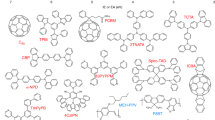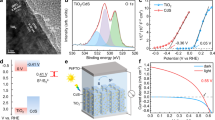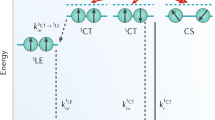Abstract
Barrier-free (Ohmic) contacts are a key requirement for efficient organic optoelectronic devices, such as organic light-emitting diodes, solar cells, and field-effect transistors. Here, we propose a simple and robust way of forming an Ohmic hole contact on organic semiconductors with a high ionization energy (IE). The injected hole current from high-work-function metal-oxide electrodes is improved by more than an order of magnitude by using an interlayer for which the sole requirement is that it has a higher IE than the organic semiconductor. Insertion of the interlayer results in electrostatic decoupling of the electrode from the semiconductor and realignment of the Fermi level with the IE of the organic semiconductor. The Ohmic-contact formation is illustrated for a number of material combinations and solves the problem of hole injection into organic semiconductors with a high IE of up to 6 eV.
This is a preview of subscription content, access via your institution
Access options
Access Nature and 54 other Nature Portfolio journals
Get Nature+, our best-value online-access subscription
$29.99 / 30 days
cancel any time
Subscribe to this journal
Receive 12 print issues and online access
$259.00 per year
only $21.58 per issue
Buy this article
- Purchase on Springer Link
- Instant access to full article PDF
Prices may be subject to local taxes which are calculated during checkout





Similar content being viewed by others
Change history
06 March 2018
In the html version of this Article originally published, Paul W. M. Blom and Gert-Jan A. H. Wetzelaer were incorrectly listed as Paul M. W. Blom and Gert-Jan H. A. Wetzelaer, respectively, due to a technical error. This has now been amended in all online versions of the Article.
References
Tao, Y., Yang, C. & Qin, J. Organic host materials for phosphorescent organic light-emitting diodes. Chem. Soc. Rev. 40, 2943–2970 (2011).
Wong, M. Y. & Zysman-Colman, E. Purely organic thermally activated delayed fluorescence materials for organic light-emitting diodes. Adv. Mater. 29, 1605444 (2017).
Koch, N. & Vollmer, A. Electrode-molecular semiconductor contacts: Work-function-dependent hole injection barriers versus Fermi-level pinning. Appl. Phys. Lett. 89, 162107 (2006).
Helander, M. G. et al. Chlorinated indium tin oxide electrodes with high work function for organic device compatibility. Science 332, 944–947 (2011).
Simmons, J. G. Richardson–Schottky effect in solids. Phys. Rev. Lett. 15, 967–968 (1965).
Méndez, H. et al. Charge-transfer crystallites as molecular electrical dopants. Nat. Commun. 6, 8560 (2015).
Tang, C. G. et al. Doped polymer semiconductors with ultrahigh and ultralow work functions for ohmic contacts. Nature 539, 536–540 (2016).
Kröger, M. et al. Role of the deep-lying electronic states of MoO3 in the enhancement of hole-injection in organic thin films. Appl. Phys. Lett. 95, 123301 (2009).
Kröger, M. et al. P-type doping of organic wide band gap materials by transition metal oxides: A case-study on molybdenum trioxide. Org. Electron. 10, 932–938 (2009).
Meyer, J. et al. Transition metal oxides for organic electronics: Energetics, device physics and applications. Adv. Mater. 24, 5408–5427 (2012).
Blom, P. W. M., de Jong, M. J. M. & Vleggaar, J. J. M. Electron and hole transport in poly(p-phenylene vinylene) devices. Appl. Phys. Lett. 68, 3308–3310 (1996).
Davids, P. S., Campbell, I. H. & Smith, D. L. Device model for single carrier organic diodes. J. Appl. Phys. 82, 6319–6325 (1997).
Belisle, R. A., Jain, P., Prasanna, R., Leijtens, T. & McGehee, M. D. Minimal effect of the hole-transport material ionization potential on the open-circuit voltage of perovskite solar cells. ACS Energy Lett. 1, 556–560 (2016).
White, R. T., Thibau, E. S. & Lu, Z.-H. Interface structure of MoO3 on organic semiconductors. Sci. Rep. 6, 21109 (2016).
Mott, N. F. & Gurney, R. W. Electronic Processes in Ionic Crystals (Oxford University Press: Oxford, 1940).
Li, C., Duan, L., Li, H. & Qiu, Y. Universal trap effect in carrier transport of disordered organic semiconductors: Transition from shallow trapping to deep trapping. J. Phys. Chem. C 118, 10651–10660 (2014).
Greiner, M. T. et al. Universal energy-level alignment of molecules on metal oxides. Nat. Mater. 11, 76–81 (2012).
Blakesley, J. C. & Greenham, N. C. Charge transfer at polymer-electrode interfaces: The effect of energetic disorder and thermal injection on band bending and open-circuit voltage. J. Appl. Phys. 106, 034507 (2009).
Oehzelt, M., Koch, N. & Heimel, G. Organic semiconductor density of states controls the energy level alignment at electrode interfaces. Nat. Comm. 5, 4174 (2014).
Oehzelt, M., Akaike, K., Koch, N. & Heimel, G. Energy-level alignment at organic heterointerfaces. Sci. Adv. 1, e1501127 (2015).
Baldo, M. A. & Forrest, S. R. Interface-limited injection in amorphous organic semiconductors. Phys. Rev. B 64, 085201 (2001).
Limketkai, B. N. & Baldo, M. A. Charge injection into cathode-doped amorphous organic semiconductors. Phys. Rev. B 71, 085207 (2005).
Seino, Y., Inomata, S., Sasabe, H., Pu, Y.-J. & Kido, J. High-performance green OLEDs using thermally activated delayed fluorescence with a power efficiency of over 100 lm W−1. Adv. Mater. 28, 2638–2643 (2016).
Hung, W.-Y. et al. Employing ambipolar oligofluorene as the charge-generation layer in time-of-flight mobility measurements of organic thin films. Appl. Phys. Lett. 88, 064102 (2006).
Tse, S. C., Kwok, K. C. & So, S. K. Electron transport in naphthylamine-based organic compounds. Appl. Phys. Lett. 89, 262102 (2006).
Bach, U., De Cloedt, K., Spreitzer, H. & Grätzel, M. Characterization of hole transport in a new class of spiro-linked oligotriphenylamine compounds. Adv. Mater. 12, 1060–1063 (2000).
Noh, S., Suman, C. K., Hong, Y. & Lee, C. Carrier conduction mechanism for phosphorescent material doped organic semiconductor. J. Appl. Phys. 105, 033709 (2009).
Matsusue, N., Suzuki, Y. & Naito, H. Charge carrier transport in neat thin films of phosphorescent iridium complexes. Jpn. J. Appl. Phys. 44, 3691–3694 (2005).
Uoyama, H., Goushi, K., Shizu, K., Nomura, H. & Adachi, C. Highly efficient organic light-emitting diodes from delayed fluorescence. Nature 492, 234–238 (2012).
Ruehle, V. et al. Microscopic simulations of charge transport in disordered organic semiconductors. J. Chem. Theory Comput. 7, 3335–3345 (2011).
Poelking, C. & Andrienko, D. Long-range embedding of molecular ions and excitations in a polarizable molecular environment. J. Chem. Theory Comput. 12, 4516–4523 (2016).
Acknowledgements
The authors thank C. Bauer, F. Keller, and H.-J. Guttmann for technical support. This project has received funding from the European Union Horizon 2020 research and innovation programme under Grant Agreement No. 646176 (EXTMOS). D.A. thanks the BMBF grant InterPhase (FKZ 13N13661) and the European Union Horizon 2020 research and innovation programme ‘Widening materials models’ under Grant Agreement No. 646259 (MOSTOPHOS).
Author information
Authors and Affiliations
Contributions
G.A.H.W. proposed and supervised the project. N.B.K. carried out sample preparation and electrical measurements. H.L. performed the UPS measurements. D.A. and A.M. performed molecular-dynamics and energy-alignment simulations. Y.I. synthesized and purified 4CzIPN. G.A.H.W., N.B.K. and P.W.M.B. analysed the experimental data. G.A.H.W. wrote the manuscript with input from D.A. and P.W.M.B.
Corresponding author
Ethics declarations
Competing interests
The authors declare no competing financial interests.
Additional information
Publisher’s note: Springer Nature remains neutral with regard to jurisdictional claims in published maps and institutional affiliations.
A correction to this article is available online at https://doi.org/10.1038/s41563-018-0043-3.
Supplementary information
Supplementary Information
Molecular structures of materials, Experimental techniques, Supporting experimental results, Molecular dynamics simulations, Density-of-states distributions, energy-level alignment calculations.
Rights and permissions
About this article
Cite this article
Kotadiya, N.B., Lu, H., Mondal, A. et al. Universal strategy for Ohmic hole injection into organic semiconductors with high ionization energies. Nature Mater 17, 329–334 (2018). https://doi.org/10.1038/s41563-018-0022-8
Received:
Accepted:
Published:
Issue Date:
DOI: https://doi.org/10.1038/s41563-018-0022-8
This article is cited by
-
Elimination of charge-carrier trapping by molecular design
Nature Materials (2023)
-
Ultralow contact resistance in organic transistors via orbital hybridization
Nature Communications (2023)
-
Uncoupling nanoparticle geometry from material properties for improved hole injection at submonolayer nanoparticle electrode interlayers in organic hole-only devices
Journal of Materials Science: Materials in Electronics (2023)
-
In situ-formed tetrahedrally coordinated double-helical metal complexes for improved coordination-activated n-doping
Nature Communications (2022)
-
Efficient and stable one-micrometre-thick organic light-emitting diodes
Nature Photonics (2022)



